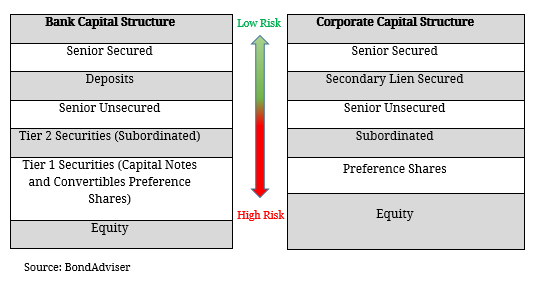Before understanding types of fixed income, investors must understand the capital structure. In its simplest form, the capital structure consists of debt and equity. Companies utilise global markets to raise debt and equity to fund growth and maintain the existing operations of the business. In the priority of payments, debt holders are ranked higher than equity holders. This means that in the event of default meaning that if the company is liquidated, debt holders are paid out before equity holders. This is because equity holders are essentially part owners of the company and are entitled to profits and benefit from growth. On the other hand, debt holders receive contractual interest payments and repayment of principal. This means that debtholders are exposed to limited upside while being subject to default risk. Therefore, for protection they are positioned above equity holders within the capital structure. Although this seems simple, complex capital structures can comprise multiple types of debt with different levels of seniority (refer to ‘Corporate Bonds’ – page 14) and it is important to identify where your potential investment lies in the priority of payments. However, equity always falls behind debt and acts as a buffer for debt holders. Companies that increase equity capital relative to debt capital are essentially shifting value from equity holders to debt holders. But over the long term, this allows companies to reduce the risk of their debt which in turn lowers the interest payments they have to pay on their outstanding securities (as investors’ required returns are less). As a result, these companies are able to lower their cost of funding for future projects and increase profitability which raises shareholder value. This reflects the balancing-act that comes with managing the capital structure as changes to the capital mix are made very regularly. It is therefore important that investors are remain vigilant to the underlying issuer’s funding strategy. In Australia, there are two main types of capital structures: Financial and Corporate. Financial institutions (i.e. banks, insurance, diversified) are subject to regulation and are required to hold excess amounts of capital to reduce the overall risks of their operations. This is especially prominent in the major banks who adhere to various capital requirements as the safety net to the wider economy. As a result, these institutions issue Tier 2 and Tier 1 securities which are classified as regulatory capital. These securities have different features to traditional subordinated features which will be looked at in more depth later but in terms of the capital structure, Tier 2 and Tier 1 are effectively just two additional layers of debt seniority. Although many phrases are used when identifying seniority, a key one to look out for is ‘subordinated’. This effectively means that your security is ranked below more senior debt, and is therefore riskier. However, due to this increased risk, these types of investments will generally pay a higher return. It is therefore crucial that investor’s understand the underlying issuer’s capital structure to help justify the risk and return inherent in a potential fixed income investment. Figure 1. General Bank and Corporate Capital Structures 

